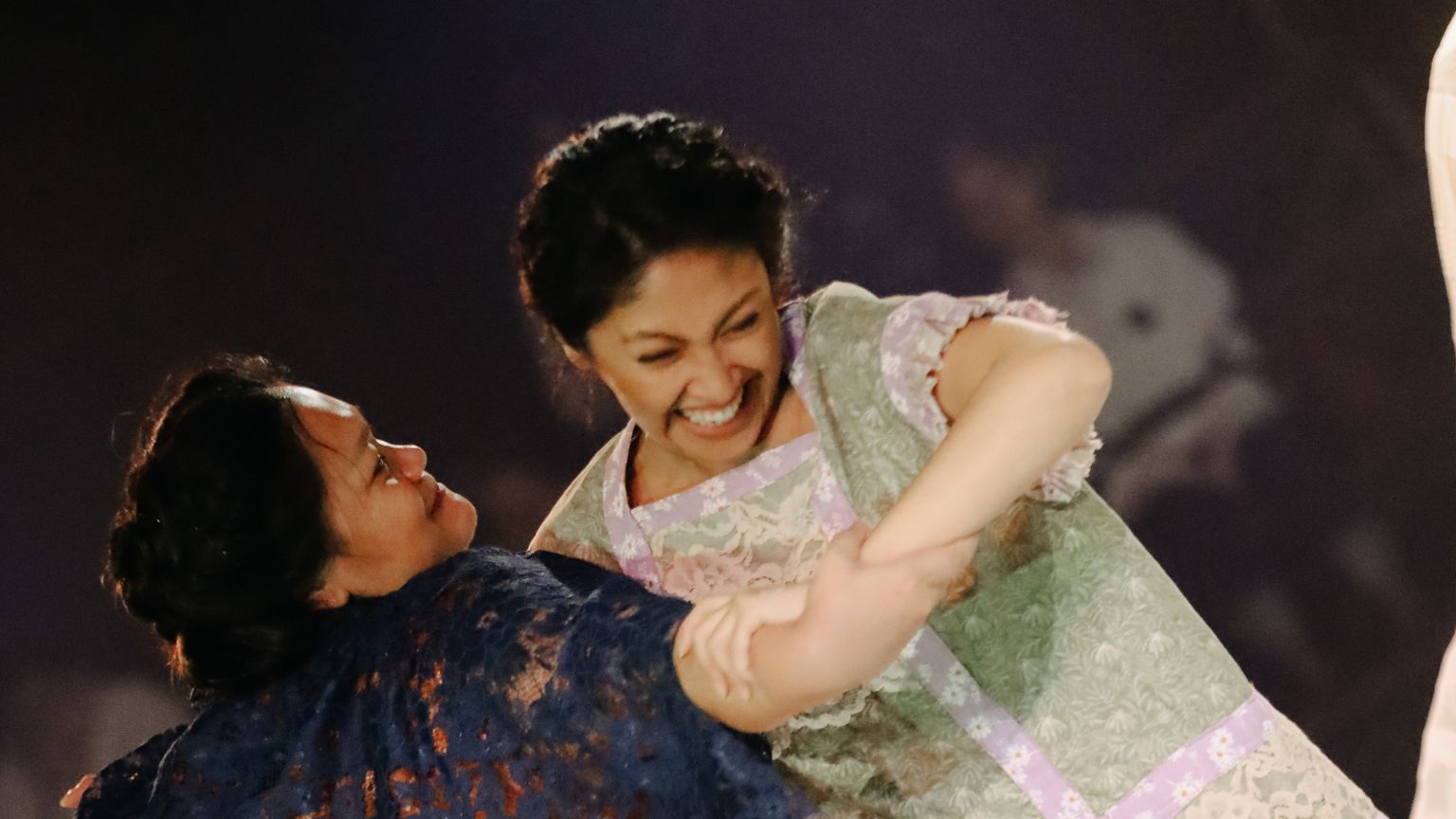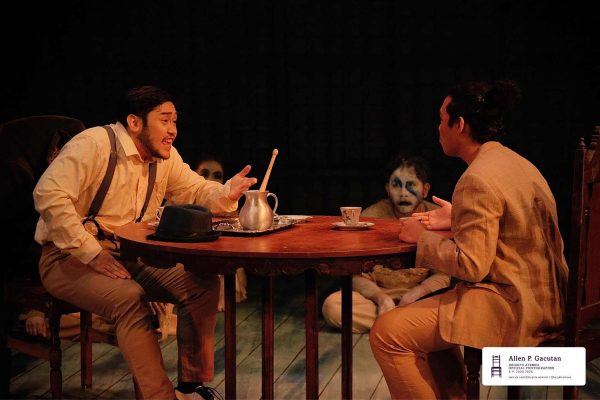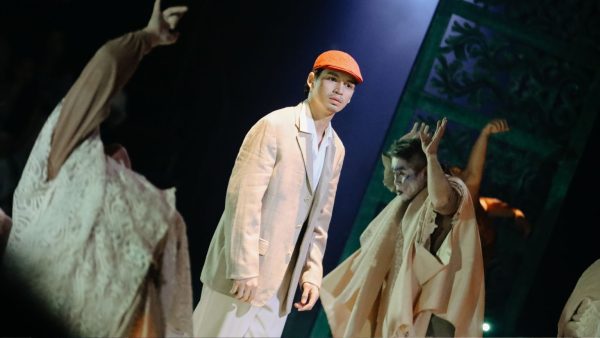
REVIEW: ‘Quomodo Desolata Es?’ casts a Filipino classic in an ominous light
“Areté Ateneo’s translation of Nick Joaquin’s ‘A Portrait of the Artist as Filipino’ succeeds as both a faithful adaptation and a subversive deconstruction.”
A play that’s as foundational and as perennially relevant as Nick Joaquin’s A Portrait of the Artist as Filipino doesn’t need to be drastically reworked to make sense for a contemporary audience. So Aretè Ateneo’s new adaptation of Portrait, now entitled Quomodo Desolata Es? Isang Dalamhati, leaves the Marasigan family’s drama as is. This is still, at its core, the story of two sisters at the onset of World War II, wrestling with the choice of selling their father’s mysterious new painting for their own survival—effectively sacrificing his artistic integrity and straining their relationship further.
What translators Jerry Respeto and Guelan Varela-Luarca do instead is reorient how the audience sees this—zooming out, rotating, and refracting our perspective until the Intramuros house becomes practically unrecognizable. By carefully conducting the show’s captivating visual elements and ever-present ensemble, Varela-Luarca (who also directs this production) gradually gets this Portrait to gaze back at us, too.
A House in the Wasteland
Mounted on a smaller stage built within Areté’s cavernous Hyundai Hall, Quomodo Desolata Es? immediately evokes a sense of setting even without giving us the ornate furnishings or the literal shape of the Marasigans’ home. Through a circular backdrop and ceiling panels rendered in capiz-shell windows (designed by D Cortezano) and Jethro Nibaten’s rays of light piercing through the set, this microcosm of Intramuros (and, in effect, the Philippines) already asks to be seen differently. Rather than focus on the lone house withstanding change and history, we’re compelled to think of the surrounding wasteland already intruding into the space, exposing the skeleton of the home that the Marasigans have been left with, now that the patriarch has hidden himself away in his chambers.
What become this production’s most prominent visual motifs are the ensemble’s patchwork filipiniana costumes (designed by Ali Figueroa) and ghostly white-and-blue makeup, as they occupy the edges of the stage for much of the show. When their bodies billow across the set with Varela-Luarca’s blocking and Ronelson Yadao’s choreography, they cast a deeper, more ominous shadow over every exchange. Even when the sisters, Candida and Paula (Delphine Buencamino and Gab Pangilinan, respectively), express their shame of wasting away unmarried, the ghosts surrounding them constantly remind us that this story has to do with much more than just their self-actualization.
A Variety of Faces

John Sanchez as Tony Javier; Photo Credit: Allen P. Gacutan
Buencamino and Pangilinan also portray Candida and Paula as more than just the fading remnants of old Manila. They still approach these characters with dignity and distinct attitudes toward their hardships, but they avoid any old-fashioned posturing that would overstate their sophistication. These are just two ordinary women living day-to-day, moment-to-moment—their time in isolation causing them to feel every emotion ten times over, be it their panic at the power being cut off or their elation at successfully catching vermin.
Their expressiveness is a deliberately sharp contrast to the more sober demeanor of the people who come into their lives, including Omar Uddin’s Bitoy—a young man who both exists in the Marasigans’ present day and is sorrowfully observing the events of the play from a distant future, himself a spirit lending his voice to the chorus. Only the character of Tony Javier (played by John Sanchez, alternating with Vino Mabalot) rings artificial, his machismo barely masking his desperation for money, but without the seductiveness that should make him a convincing temptation away from the Marasigans’ family obligations.
But these individual performances are all eventually absorbed by the members of the show’s chorus and the variety of faces they put on, ranging from grief and numbness to full-tilt madness. In one moment they sit as passive observers, while in another they move in agreement with the characters—before turning their backs on them, muttering and commenting disapprovingly on their actions. In their most agitated state, the chorus rushes the stage and swallows up characters who’ve lost their purpose in the story. And yet, even if the chorus may come to represent the greater forces of history, society or, in fact, the author’s voice, they can’t actually change what’s already transpired, try as they may to wrestle with the past.
Reclaiming the Land

Omar Uddin as Bitoy; Photo Credit: Yan Caringal
Despite all these opposing perspectives jostling for control, Respeto and Varela-Luarca preserve Portrait’s dense study of artistic integrity versus the more practical demands of living in turbulent times. Quomodo Desolata Es? still makes for compelling drama about two women trying to navigate a patriarchal world, written in clear, cutting language deployed at a surprisingly brisk pace (and picked up with remarkable clarity thanks to John Robert Yam’s sound design, with the exception of several moments when the ensemble’s overlapping lines garble into gibberish). And all the while, the production doesn’t lose sight of the greater allegorical struggle of the Philippines always being forced to sacrifice its identity to new invading powers and the devil of capital.
As the play concludes its central story, it takes a while to regain momentum heading into its extended epilogue—but once it does, it succeeds in casting Joaquin’s story in a strikingly uneasy, ambiguous light. Respeto and Varela-Luarca deny us the satisfaction of any kind of romantic escape. Bitoy’s final speech of remembering and being spurred on by the glory of the past suddenly seems to question itself. For a moment, the play seems to turn to the audience, not to encourage but to earnestly ask what can actually still be done—especially through art and through theater—to reclaim a land already so stripped bare.
Tickets: P999 – P1499
Show Dates: Aug 8–17 2025
Venue: Hyundai Hall, Areté Ateneo de Manila University, Quezon City
Running Time: approximately 1 hours and 30 minutes (without intermission)
Creatives: Nick Joaquin (Playwright), Jerry Respeto (Translation), Guelan Varela-Luarca (Translation, Direction), Ronelson Yadao (Choreography), Giancarlo Abrahan (Dramaturgy), D Cortezano (Set Design, Props), Jethro Nibaten (Lighting Design), Ali Figueroa (Costume Design), John Robert Yam (Sound Design), Matthew Chang (Music), Missy Maramara (Intimacy Direction), Jed Descutido (Graphic Design)
Cast: Gab Pangilinan, Delphine Buencamino, Omar Uddin, Vino Mabalot, John Sanchez, Brian Sy, Maita Ponce, Mikaela Regis, Jethro Tenorio, Meyanne Plamenio Cortezano, JJ Ignacio, Rafael Jimenez, Roldine Ebrada, Chantei Cortez
Company: Areté Ateneo


Comments